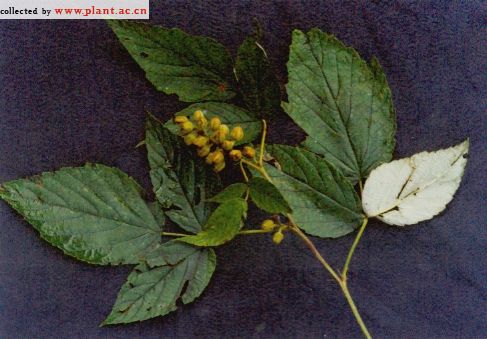白叶莓Rubus innominatus S. Moore
白叶莓Rubus innominatus S. Moore
6.白叶莓(经济植物手册)白叶悬钩子(秦岭植物志),刺泡(陕西)
Rubus innominatus S. Moore in Journ. Bot. 13: 226. 1875: Focke, Bibl. Bot 72(2): 195. 1911 et in Sarg Pl. Wils. 1: 55. 1911: Rehd. in Journ. Arn. Arb. 5: 198. 1924; Rehd. et Wils. in Journ. Arn. Arb. 8: 124. 1927; Chun in Sunyatsenia 2: 65. 1934; Lauener et Ferguson in Not. Roy. Bot. Gard. Edinb. 30(2): 273. 1970;中国高等植物图鉴2: 281.图2292. 1972; 秦岭植物志1(2): 539. 1974。——R. xanthacantha Levl. in Fedde, Repert. Sp. Nov. 4: 333. 1907; Focke, Bibl. Bot. 72(2): 195. 1911. pro syn. sub R. kuntzeanus Hemsl.: Rehd. in Journ Arn. Arb. 18: 49. 1937. pro syn. sub R. innominatus S. Moore var. kuntzeanus (Hemsl.) Bailey——R. kuntzeanus Hemsl. var. xanthacantha (Levl.) Levl. Fl. Kouy-Tcheou 360. 1915. ——R. kuntzeanus Hemsl. var. glandulosus Card. in Not. Syst. 3: 311. 1914.
《Flora of China》 Vol. 9 (2003)
Rubus innominatus S. Moore
白叶莓 bai ye mei
Shrubs 1–3 m tall, with arching branches. Branchlets brown or reddish brown, densely tomentose, with sparse, curved prickles. Leaves imparipinnately compound, 3-foliolate, rarely 5-foliolate on sterile branches; petiole 2–4 cm, petiolule of terminal leaflet 1–2 cm, lateral leaflets nearly sessile, petiolule and rachis densely tomentose; stipules linear, 6–8 mm, pubescent; blade of leaflets variable in shape, 4–10 × 2.5–5(–7) cm, terminal one ovate or suborbicular, rarely ovate-lanceolate, base rounded to shallowly cordate, margin 3-lobed or incised-lobed, lateral leaflets obliquely ovate-lanceolate or elliptic, base cuneate to rounded, abaxially densely gray tomentose, adaxially appressed pubescent or subglabrous, margin unevenly coarsely serrate or incised doubly serrate, apex acute to shortly acuminate. Inflorescences terminal or axillary, subracemes or narrow cymose panicles, 6–13(–18) cm; rachis, pedicels, and abaxial surface of calyx densely yellowish gray or gray tomentose-villous and stipitate glandular; bracts linear-lanceolate, tomentose-villous. Pedicel 4–10 mm. Flowers 6–10 mm in diam. Sepals erect, ovate, 5–9(–12) × 3–5 mm, inner sepals gray tomentose-villous at margin, apex acute. Petals purple, obovate or suborbicular, nearly as long as sepals, margin premorse, base clawed. Stamens many, shorter than petals. Pistils numerous, slightly shorter than stamens; ovary slightly soft hairy; styles glabrous. Aggregate fruit orange-red, subglobose, ca. 1 cm in diam., initially sparsely soft hairy, glabrous at maturity; pyrenes minutely rugose. Fl. May–Jun, fr. Jul–Aug. 2n = 14*.
Dense or sparse forests, thickets, slopes, roadsides, stream sides, river sides; 400--2500 m. Anhui, Fujian, Gansu, Guangdong, Guangxi, Guizhou, Henan, Hubei, Hunan, Jiangxi, Shaanxi, Sichuan, Yunnan, Zhejiang.
别名:黄豆泡;白叶悬钩子;无名黄龙须;刺泡;天腺白叶莓;大红袍;白背叶悬钩子;小米泡;
科名:蔷薇科 Rosaceae
属名:悬钩子属 Rubus

6.白叶莓(经济植物手册)白叶悬钩子(秦岭植物志),刺泡(陕西)
Rubus innominatus S. Moore in Journ. Bot. 13: 226. 1875: Focke, Bibl. Bot 72(2): 195. 1911 et in Sarg Pl. Wils. 1: 55. 1911: Rehd. in Journ. Arn. Arb. 5: 198. 1924; Rehd. et Wils. in Journ. Arn. Arb. 8: 124. 1927; Chun in Sunyatsenia 2: 65. 1934; Lauener et Ferguson in Not. Roy. Bot. Gard. Edinb. 30(2): 273. 1970;中国高等植物图鉴2: 281.图2292. 1972; 秦岭植物志1(2): 539. 1974。——R. xanthacantha Levl. in Fedde, Repert. Sp. Nov. 4: 333. 1907; Focke, Bibl. Bot. 72(2): 195. 1911. pro syn. sub R. kuntzeanus Hemsl.: Rehd. in Journ Arn. Arb. 18: 49. 1937. pro syn. sub R. innominatus S. Moore var. kuntzeanus (Hemsl.) Bailey——R. kuntzeanus Hemsl. var. xanthacantha (Levl.) Levl. Fl. Kouy-Tcheou 360. 1915. ——R. kuntzeanus Hemsl. var. glandulosus Card. in Not. Syst. 3: 311. 1914.
《Flora of China》 Vol. 9 (2003)
Rubus innominatus S. Moore
白叶莓 bai ye mei
Shrubs 1–3 m tall, with arching branches. Branchlets brown or reddish brown, densely tomentose, with sparse, curved prickles. Leaves imparipinnately compound, 3-foliolate, rarely 5-foliolate on sterile branches; petiole 2–4 cm, petiolule of terminal leaflet 1–2 cm, lateral leaflets nearly sessile, petiolule and rachis densely tomentose; stipules linear, 6–8 mm, pubescent; blade of leaflets variable in shape, 4–10 × 2.5–5(–7) cm, terminal one ovate or suborbicular, rarely ovate-lanceolate, base rounded to shallowly cordate, margin 3-lobed or incised-lobed, lateral leaflets obliquely ovate-lanceolate or elliptic, base cuneate to rounded, abaxially densely gray tomentose, adaxially appressed pubescent or subglabrous, margin unevenly coarsely serrate or incised doubly serrate, apex acute to shortly acuminate. Inflorescences terminal or axillary, subracemes or narrow cymose panicles, 6–13(–18) cm; rachis, pedicels, and abaxial surface of calyx densely yellowish gray or gray tomentose-villous and stipitate glandular; bracts linear-lanceolate, tomentose-villous. Pedicel 4–10 mm. Flowers 6–10 mm in diam. Sepals erect, ovate, 5–9(–12) × 3–5 mm, inner sepals gray tomentose-villous at margin, apex acute. Petals purple, obovate or suborbicular, nearly as long as sepals, margin premorse, base clawed. Stamens many, shorter than petals. Pistils numerous, slightly shorter than stamens; ovary slightly soft hairy; styles glabrous. Aggregate fruit orange-red, subglobose, ca. 1 cm in diam., initially sparsely soft hairy, glabrous at maturity; pyrenes minutely rugose. Fl. May–Jun, fr. Jul–Aug. 2n = 14*.
Dense or sparse forests, thickets, slopes, roadsides, stream sides, river sides; 400--2500 m. Anhui, Fujian, Gansu, Guangdong, Guangxi, Guizhou, Henan, Hubei, Hunan, Jiangxi, Shaanxi, Sichuan, Yunnan, Zhejiang.

